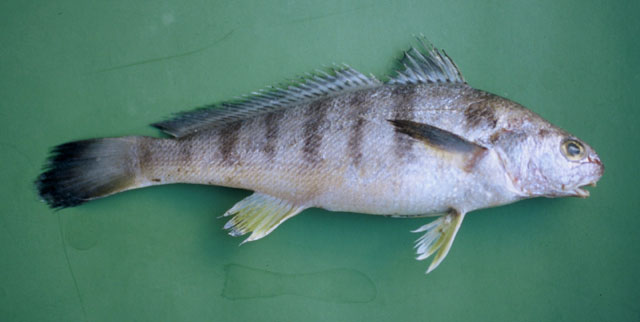| Sciaenidae (Drums or croakers) |
| 33.7 cm TL (male/unsexed); max.weight: 520.0 g |
|
demersal; brackish; marine; depth range - 50 m |
| Western Atlantic: Panama to southern Brazil. Reported in Yucatan, Mexico (Ref. 74908). |
|
Dorsal spines (total): 11-12; Dorsal soft rays (total): 29-30; Anal spines: 2-2; Anal soft rays: 8-8. Body silvery to yellowish, brown above, whitish below. Sides with 7 to 9 dark vertical bars extending to below lateral line. A large dark brown spot, larger than eye, behind upper end of gill slit. Mouth small, inferior, nearly horizontal. Chin with 5 pores and many barbels, 3 or 4 pairs in a tuft around median pore and 10 to 12 pairs along inner edges of lower jaw. Caudal fin asymmetrically rhomboidal with lower half pointed. Gas bladder well developed, much longer than head length, bearing anteriorly 2 pairs of appendages, anterior pair slit and horn-like, lateral pair long, tube-like, and extending posteriorly to tip of main chamber (Ref 51721). |
| Found over muddy bottoms, often near estuarine areas (Ref. 9626). Feeds mainly on worms (Ref. 3702). Marketed mostly fresh and salted (Ref. 3702). |
|
Least Concern (LC); Date assessed: 23 January 2020 Ref. (130435)
|
| harmless |
Source and more info: www.fishbase.org. For personal, classroom, and other internal use only. Not for publication.

